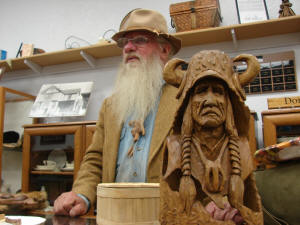|
 Master
craftsman, artisan, John Sutton talks wood carving Master
craftsman, artisan, John Sutton talks wood carving
 Send a link to a friend
Send a link to a friend
[October 26, 2015]
LINCOLN
- The Logan County Genealogical and Historical Society welcomed wood
carver John Sutton to their October monthly meeting Monday. Sutton
is nationally known for his artistry with a knife and a gouge,
creating intricate wood carvings that can be whimsical or serious.
|
|
 Sutton began carving as a Cub Scout where he learned the proper
way to use a knife on wood. It was not just creating a sharp point
on a stick with a pocket knife, but rather drawing the knife against
the wood in order to control how the wood can be shaped. He has been
at it since, and his works of art have run the gamut from almost
dimensional figures to creation and restoration of carousel horses
and cigar store Indians. Sutton began carving as a Cub Scout where he learned the proper
way to use a knife on wood. It was not just creating a sharp point
on a stick with a pocket knife, but rather drawing the knife against
the wood in order to control how the wood can be shaped. He has been
at it since, and his works of art have run the gamut from almost
dimensional figures to creation and restoration of carousel horses
and cigar store Indians.
His reputation is nationwide as evidenced by a project he did for a
wealthy individual in San Antonio who wanted his personal carousel
restored to its original glory. He shipped seventeen wooden horses
to Sutton for restoration. That project took a year. During the
project Sutton determined that a previous restoration attempt had
involved filling in damage to the horses with plaster. “I could tell
the moment I touched the horses that there was something wrong with
them. They had a cold feel to them, not the warm touch of wood. I
took a large mallet and smacked a horse and the plaster shattered. I
had to replace all of that with wood,” he said. Sutton personally
returned the wooden carousel horses to their owner after the project
was complete, which involved driving through a blizzard to get the
job done.

 Sutton
discussed the many techniques for taking a simple block of wood and
turning it into a work of art. “There are two main ways of carving,
the European method and the American way,” he said. European is
characterized by very intricate design and attention to the smallest
detail, while American is characterized by fast carving that takes
much less time. Some of the European works take years to complete,
sometimes involving making only one cut a day while the carver
considers his next move, sort of a chess game with wood. There are
even techniques that are common to one country. Swedish carving
involves lots of flat planes on the figures. Sutton
discussed the many techniques for taking a simple block of wood and
turning it into a work of art. “There are two main ways of carving,
the European method and the American way,” he said. European is
characterized by very intricate design and attention to the smallest
detail, while American is characterized by fast carving that takes
much less time. Some of the European works take years to complete,
sometimes involving making only one cut a day while the carver
considers his next move, sort of a chess game with wood. There are
even techniques that are common to one country. Swedish carving
involves lots of flat planes on the figures.
Carving is such a personal art that Sutton can tell just from the
way an object has been carved who the artist was. This was in
evidence from his discussion of carousel horses. There were several
companies back in the day whose sole business was creating
carousels. When he does restoration work on the horses, he can tell
from the anatomy of the horse which company was responsible for its
creation.
[to top of second column] |

The two most important tools that a wood carver can have are a
gouge and a very sharp knife. “If a knife is razor sharp, you are
almost there,” he said with a laugh. Sharpening a knife is a skill
that a wood carver needs to develop. The tools needed for sharpening
are not expensive, but technique is everything. Sutton buys old
leather shoes and belts to use in the sharpening process. The way
the knife is pulled against the leather is an art in itself, called
stropping. Sutton grinned when he said, “Cutting yourself while
sharpening your carving knife is an everyday occurrence. I have bled
a lot over the years.”
When asked how a person can get started in learning to carve
wood, Sutton said a sharp knife, a few gouges of different sizes,
and an easy wood to carve are important. “Bass wood is the easiest
wood to carve because it is soft and the grain is easy to read.
Learning how the grain of wood affects the carving process is
vital,” he said.
Carving clubs offer classes that can help a novice carver learn the
basics. There is a local club that meets in Williamsville. With
practice, a carver can see the object that is being created in the
wood and remove all of the extraneous material. For some very
complex projects, Sutton will create the finished project in clay
and then transfer the shape to wood. “You can screw up clay and just
add more to change the shape, to fix it. With wood, you are taking
away material. You only get one chance to get it right with wood,”
he said. “I have created a lot of firewood over the years,” he said
with a smile.
[Curt Fox]
The Logan County
Genealogical and Historical Society meets monthly on the third
Monday at 6:30 p.m. at the research facility at 114 North Chicago
Street in Lincoln. They always have a fascinating speaker, and the
public is always welcome.
 |